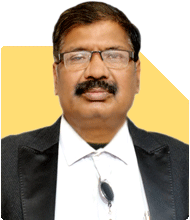Ramalingam Kalirajan |8086 Answers |Ask -Follow
Mutual Funds, Financial Planning Expert - Answered on May 20, 2024
He has an MBA in finance from the University of Madras and is a certified financial planner.
He is the director and chief financial planner at Holistic Investment, a Chennai-based firm that offers financial planning and wealth management advice.... more

Hi Sir, My age is 33, married, one kid. Wife homemaker. Income details: My salary is 34L fixed. Almost 1.9L in-hand post tax, pf and nps. I get 14k rent, parents staying. Existing mutual funds 4L Pf existing amount 15L. NPS existing amount is 5L. Neatly 18lakh US stocks. Noida house value now: 60L Bengaluru house value: 90L Spending and investment details: Monthly EMI is 1L(bought two flats in Noida and Bangalore) Mutual funds monthly 6.5k Vpf is 2% of CTC. Rest amount for monthly house needs. My question is what changes i should make in my spending. I am planning to increase EMI size of new home by 20k which i took last year, but feel i am investment low on equity, even though my company invests 10% of CTC towards NPS which is in agressive equity mode. Just want to understand some tips to retire by 50 years. Thanks.
Your current monthly EMI of ?1 lakh for two properties in Noida and Bengaluru is substantial. Additionally, you invest ?6,500 monthly in mutual funds and contribute 2% of your CTC to VPF. These commitments need careful management to achieve your retirement goal by 50.
Your company’s NPS contribution in aggressive equity mode is advantageous. However, it's essential to diversify your portfolio while keeping your risk tolerance in mind.
Evaluating Your Equity Investment Strategy
Increasing your equity investments can enhance growth potential. Currently, your equity exposure includes mutual funds and US stocks. Equity investments typically yield higher returns over the long term but come with higher risk.
Your mutual fund investments are relatively low at ?6,500 per month. Increasing this amount can boost your equity portfolio, potentially accelerating your path to early retirement. Actively managed funds could be beneficial here. They offer the potential for higher returns through professional management, adapting to market changes.
Disadvantages of Index Funds
Index funds might seem appealing due to their low cost and market-matching returns. However, they lack flexibility and can underperform in volatile markets. Actively managed funds, although higher in cost, can potentially outperform by leveraging the expertise of fund managers.
Reviewing Direct and Regular Mutual Funds
Direct mutual funds bypass intermediaries, offering lower expense ratios. However, they require extensive market knowledge and active monitoring. Regular funds, through a Certified Financial Planner, provide guidance and strategic management, aligning with your long-term goals.
Regular funds, managed by a Certified Financial Planner, ensure professional oversight. This can optimize your portfolio performance, balancing growth and risk.
Managing EMI and Debt
Increasing your EMI by ?20,000 for the new home needs careful consideration. While paying off loans faster saves on interest, it reduces cash flow for other investments. Assess the impact on your monthly budget and overall investment capacity.
Consider whether this increased EMI aligns with your long-term goal of retiring by 50. Balancing debt repayment with strategic investments is crucial.
Planning for Early Retirement
To retire by 50, you need a robust retirement corpus. This requires maximizing savings and optimizing your investment strategy. Your existing assets, including properties and investments, provide a strong base.
Strategic Investment Planning
Increase Equity Investments: Allocate more funds to equity, through actively managed mutual funds, to potentially enhance returns.
Diversify Portfolio: Include a mix of equity and debt instruments to balance risk and ensure steady growth.
Professional Management: Utilize the expertise of a Certified Financial Planner to manage and monitor your portfolio, adapting to market conditions.
Emergency Fund: Ensure you have a sufficient emergency fund, covering at least 6-12 months of expenses, to handle unforeseen circumstances.
Review and Adjust: Regularly review your financial plan and make adjustments as needed, ensuring alignment with your retirement goal.
Conclusion
Your current financial status is commendable. With strategic adjustments, particularly in increasing equity investments and managing debt, you can enhance your path to early retirement. Professional guidance will ensure your portfolio aligns with your long-term goals, providing stability and growth.
Best Regards,
K. Ramalingam, MBA, CFP,
Chief Financial Planner,
www.holisticinvestment.in
You may like to see similar questions and answers below
Ramalingam Kalirajan |8086 Answers |Ask -Follow
Mutual Funds, Financial Planning Expert - Answered on Jul 27, 2024
Ramalingam Kalirajan |8086 Answers |Ask -Follow
Mutual Funds, Financial Planning Expert - Answered on Aug 07, 2024
Ramalingam Kalirajan |8086 Answers |Ask -Follow
Mutual Funds, Financial Planning Expert - Answered on Oct 18, 2024
Ramalingam Kalirajan |8086 Answers |Ask -Follow
Mutual Funds, Financial Planning Expert - Answered on Nov 07, 2024
Shalini Singh |148 Answers |Ask -Follow
Dating Coach - Answered on Mar 09, 2025
Rajesh Kumar Singh |170 Answers |Ask -Follow
IIT-JEE, GATE Expert - Answered on Mar 09, 2025
Radheshyam Zanwar |1384 Answers |Ask -Follow
MHT-CET, IIT-JEE, NEET-UG Expert - Answered on Mar 09, 2025
Radheshyam Zanwar |1384 Answers |Ask -Follow
MHT-CET, IIT-JEE, NEET-UG Expert - Answered on Mar 09, 2025
Radheshyam Zanwar |1384 Answers |Ask -Follow
MHT-CET, IIT-JEE, NEET-UG Expert - Answered on Mar 09, 2025
Radheshyam Zanwar |1384 Answers |Ask -Follow
MHT-CET, IIT-JEE, NEET-UG Expert - Answered on Mar 09, 2025
Radheshyam Zanwar |1384 Answers |Ask -Follow
MHT-CET, IIT-JEE, NEET-UG Expert - Answered on Mar 09, 2025
Radheshyam Zanwar |1384 Answers |Ask -Follow
MHT-CET, IIT-JEE, NEET-UG Expert - Answered on Mar 09, 2025
Radheshyam Zanwar |1384 Answers |Ask -Follow
MHT-CET, IIT-JEE, NEET-UG Expert - Answered on Mar 09, 2025
Mayank Chandel |2093 Answers |Ask -Follow
IIT-JEE, NEET-UG, SAT, CLAT, CA, CS Exam Expert - Answered on Mar 09, 2025



















